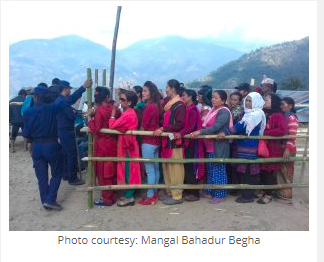Analysis
Factsheet: Electoral Violence and Contestation during Nepal’s First Phase – House of Representatives and Provincial Assembly Elections
2017-11-28

House of Representative and Provincial Assembly Elections, Campaign Silence Period & Election Day: First Phase
November 24 to 26, 2017
On November 26, Nepal held the first of two phases of elections to the House of Representatives and provincial assemblies. Voting took place in 32 mountain and upper-hill districts. 3,191,945 registered voters were eligible to cast their ballots on election day. According to a provisional estimate by the Election Commission of Nepal (ECN) voter turnout was 65 percent. First phase ballots will be stored and counted only after second phase polls close on December 7. The elections were held shortly after the conclusion of local elections that happened in three phases, the first phase being held on May 14, the second June 28, and the third September 18. The November 26 first phase elections campaign silence period and polling day were largely peaceful with isolated incidents of clashes and detonation of Improvised Explosive Devices (IEDs) being reported in several districts across the the country. During the campaign period the use of IEDs to target senior leaders and disrupt election campaign events prompted considerable security concerns.
Nepal Monitor recorded 85 election-related incidents (72 violent and 13 non-violent) that led to the injury of 51 people during the campaign silence period and on election day. This compares to 66 violent incidents recorded during the campaign silence period and on election day of the first phase of the local elections, 85 during the second, and 10 during the third phase.
This factsheet provides an overview of election-related incidents that occurred during the campaign silence period and polling, and is based on preliminary data recorded by NepalMonitor.org from 12:00 AM on November 24 until 12:00 PM on November 27. It complements previous factsheets released during Nepal’s Local Elections 2017 and regular Analysis Updates on election-related incidents that have been published since March 2017.
Background: Nepal’s House of Representatives and Provincial Assembly Elections
On August 21, the Government of Nepal (GoN) announced that elections to the federal parliament and provincial assemblies would be held on November 26. However, on August 30 the GoN revised its decision and announced elections will be held in two phases, on November 26 and December 7, due to concerns about logistical management and weather conditions.
These are the first national and provincial elections under the new constitution promulgated on September 20, 2015, and the first ever elections to newly created provincial assemblies. These elections are an important step in Nepal’s transition towards a federal state.
In the runup to the polls, several political parties worked to form political alliances, including the Communist Party of Nepal – United Marxist-Leninist (CPN-UML) and the Communist Party of Nepal (Maoist Centre)[CPN (MC)], which announced the formation of what has been deemed the “left alliance” on October 3. Following this announcement of the “left alliance”, the Nepali Congress (NC) established the ‘Democratic Electoral Alliance’ on October 4, including Rasthriya Prajantatra Party (RPP), and RPP-Nepal. Naya Shakti Party joined the alliance later. The alliances are expected to significantly reshape Nepal’s fragmented political landscape.
On October 22, first phase nomination day, 320 candidates had registered to run for one of the 37 seats in the House of Representatives and 482 candidates for the 74 seats in six provincial assemblies. Of the total number of registered candidates, 702 eventually contested the elections. 282 (266 male and 16 female) ran for a seat in the House of Representatives, and 420 (400 male and 20 female) for a seat in one of the seven provincial assemblies.
To download the factsheet, please click here.

